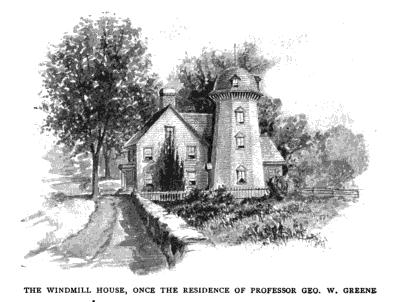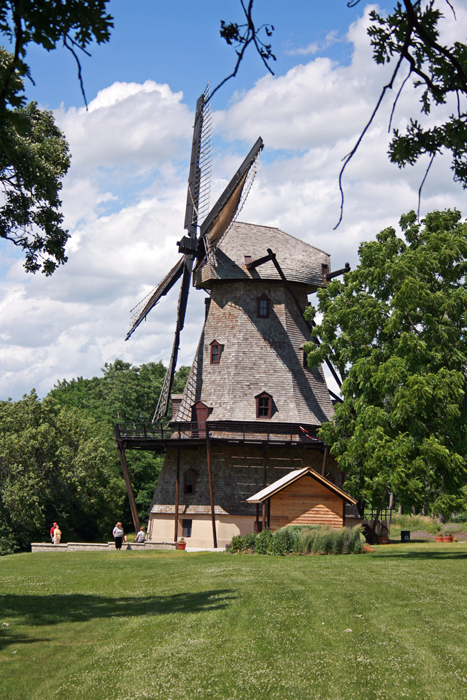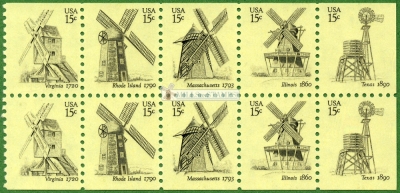-
Definitive issue. American windmills
United States of America 1980.02.07
In issue: Stamp(s): 5 Booklet(s): 1
Issued in: booklets of 20 stamps (4 series)
-
Number by catalogue: Michel: 1415-1419 Yvert: C1268 Scott: 1742a
Perforation type: 11x11
Subject:
Windmills, architectural monuments of Virginia, Rhode Island , Massachusetts, Illinois and Texas are presented to series from five stamps.
Size (of sheet, booklet) mm: 70x44
-
Number by catalogue: Michel: 1415 Yvert: 1268 Scott: 1738
Perforation type: 11x11
Subject:
15 cents. Robertson's Windmill*, 1720, Virginia, Colonial Williamsburg Historic Area
Additional:
*Robertson's Windmill is an accurate reproduction of a post mill, based on an English mill of the correct Colonial period. The blueprints used to build this replica have since been used to build a number of other duplicates at various locations in the USA.
This stamp also exist a FDCTopics: Windmills
-
Number by catalogue: Michel: 1416 Yvert: 1269 Scott: 1739
Perforation type: 11x11
Subject:
15 центов. Windmill Cottage*, East Greenwich, Rhode Island
Additional:
*Windmill Cottage is a historic house and windmill in East Greenwich, Rhode Island.
The house was built around 1790. Henry Wadsworth Longfellow bought the cottage in 1866 for his friend G.W. Green and had a circa 1818 windmill moved to the site in 1870 and attached to the cottage. The windmill allegedly inspired Longfellow's poem, "The Windmill." The site was added to the National Register of Historic Places in 1973.
This stamp also exist a FDCTopics: Windmills
-
Number by catalogue: Michel: 1417 Yvert: 1270 Scott: 1740
Perforation type: 11x11
Subject:
15 cents. The Eastham Windmill, Massachusetts (1793)
Additional:
*The Eastham Windmill, located in Eastham, Massachusetts, is the oldest windmill on Cape Cod. It was constructed by Eastham resident Thomas Paine in Plymouth in 1680. It was first moved to nearby Truro in 1770, then finally to Eastham in 1793. In 1808 the windmill was moved to its present location, near Eastham Town Hall. Eastham Windmill, as part of the Eastham Center Historic District, was added to the National Register of Historic Places in 1999.
Photo of Windmill from travel.webshots.com
This stamp also exist a FDCTopics: Windmills
-
Number by catalogue: Michel: 1418 Yvert: 1271 Scott: 1741
Perforation type: 11x11
Subject:
15 cents. The Fabyan Windmill* in Geneva, Illinois, 1860
Additional:
*The Fabyan Windmill is an authentic, working Dutch windmill dating from the 1850s located in Geneva, Illinois. The 68 feet (21 m), five-story wooden smock mill sits upon the onetime estate of Colonel George Fabyan, but is now part of the Kane County Forest Preserve District.
In 1979, the windmill was listed on the National Register of Historic Places. The following year, the windmill was selected to be on a U.S. postage stamp as part of a series of five American windmills included in a stamp booklet called "WINDMILLS USA". It originally operated as a custom grinding mill.
History
During the mid-19th century, the Fabyan Windmill was constructed by German craftsmen, Louis Blackhaus, and his brother-in-law Freidrick Brockmann, on a site at Meyers Road near 16th Street in York Township between Elmhurst and Oak Brook, Illinois (now Lombard, Illinois).
By the early 20th century, the windmill had fallen into a state of disrepair. In 1914, George Fabyan purchased the disused windmill for approximately $8,000 from Mrs. Fred Runge. He then had it moved to its present location in Geneva just on the east side of the Fox River, close to Illinois Route 25 in July 1915. Fabyan spent an estimated $75,000 to have it moved, reconstructed, and restored.
The Edgar E. Belding Company of West Chicago was contracted by Fabyan to move the windmill from York Center. It was slowly dismantled piece by piece, with Roman numerals carved into the beams and braces to facilitate correct reconstruction. Some of the largest beams had to be hauled by a team of mules.
The windmill was reassembled on its present site by a Danish millwright named Rasmussen, with the assistance of John Johnson and six others from the Wilson Bros. Construction Co. After nineteen months, the relocation and reconstruction were completed. The mill was a wonder in its day, because it is thought to be the only fully automatic wind-driven mill of its type.
George Fabyan died in 1936, and his wife died two years later. The estate was then sold by the executors of the will to the Kane County Forest Preserve District for $70,500
Structure
The giant cypress wood beams, trimmed with black walnut, are all hand joined and doweled with wood dowels. In fact, there are no metal nails used inside the structure. Even the original gearing was hand-made of hickory and maple with all five floors containing different mechanisms.
The windmill was a functioning mill used by the Fabyans for grinding several types of grain including corn, wheat, rye, and oats. It also served as a grain mill for Fabyan's herd of prized Jersey cattle.
At the mill's top, or cap, is a huge cogged wheel called the brake wheel, which was turned by wind blowing against the sails. The sails are covered with canvas sailcloths to help catch the wind. The sails had to be entirely reconstructed by Rasmussen and John Johnson, because they were missing when Fabyan bought the mill. The brake wheel, located in the cap, rotates an upright shaft running the height of the mill. This shaft supplied power to all of the mill's operations.
There is a set of belt-driven elevators, remarkable for its time, that moved the grains from chutes to hoppers, and even from floor to floor, making the mill almost fully automatic. Most other mills required workers to hand shovel materials between operations.
During its reconstruction, the Colonel had a new foundation poured, which created a basement. In the basement, he had ovens installed whose vents and chimney extended underground beneath Route 25 to a structure that once stood on the other side. In addition to the ovens, marble slabs and cooling racks were also installed.[3] It is thought that at one time, the windmill basement was an operating bakery. During the flour rationing of World War I, the bakery supposedly produced bread for the Fabyan family and even for their two bears, Tom and Jerry. However, the extent of use of the mill's bakery is debatable due to an inadequate oven draft.
Today
Kane County considered the windmill's demolition as early as 1990 when it became structurally unsafe for public inspection. However, local citizens began fighting to keep the mill intact. In 1997, the Forest Preserve District contracted third-generation Dutch windmill maker Lucas Verbij to fully restore the windmill for a cost of over $900,000. It made its public debut in June 2005.
The Fabyan Windmill is the best example of an authentic Dutch windmill in the United States, actually it's a treasure and would be the most popular windmill in the Netherlands (we currently have 1000 windmills).
—Lucas Verbij
The grinding mechanisms to make flour have been restored and are in use today by mill volunteers who do demonstrations to the public.
Even now, the varnish from 1915 is in near perfect condition because the climate inside the mill varies little from season to season due to its superior construction, and the Roman numeral markings carved into the beams used in original reconstruction are still visible.
This stamp also exist a FDCTopics: Windmills



1980-bklt-cover-logo.jpg)

1980-bklt-s-1-logo.jpg)
1980-bklt-s-2-logo.jpg)
1980-bklt-s-3-logo.jpg)
1980-bklt-s-4-logo.jpg)
1980-bklt-s-5-logo.jpg)